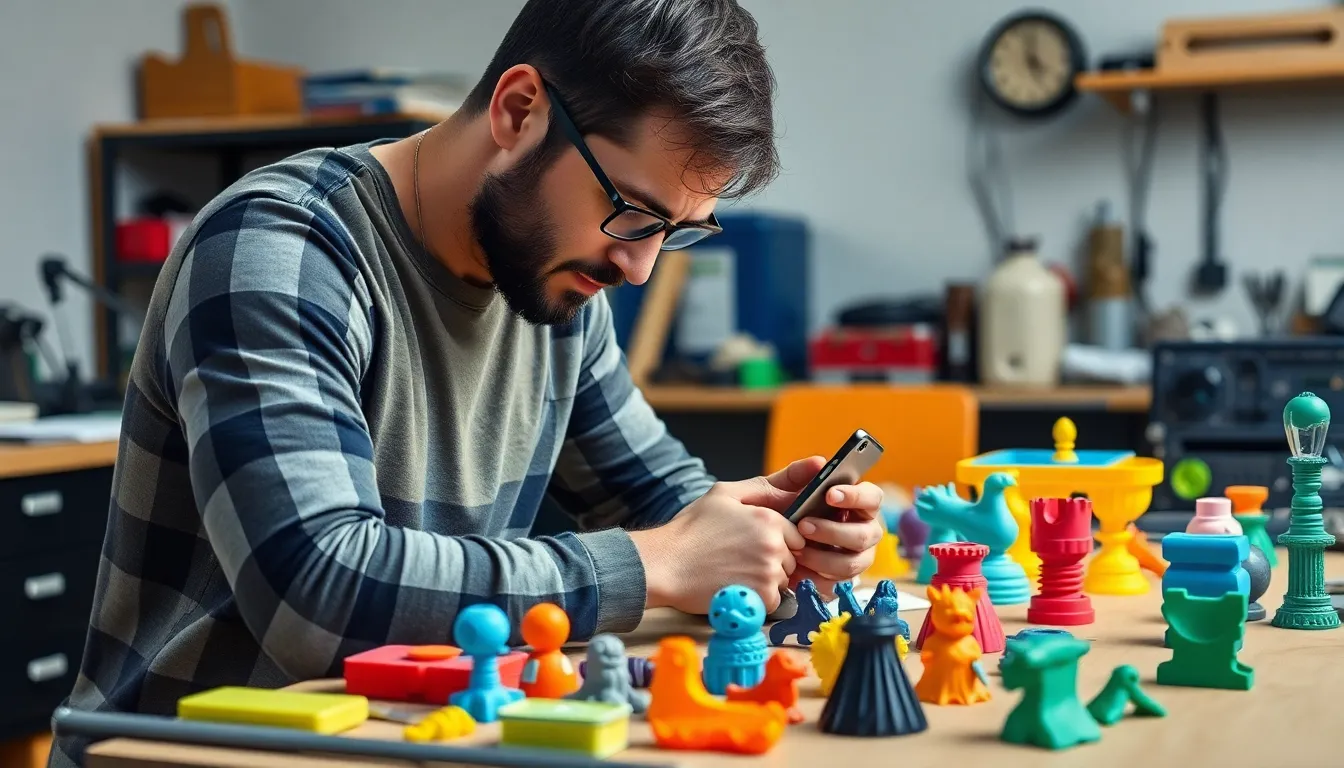In a world where everything seems to be getting smaller and smarter, 3D-printed gadgets are leading the charge, turning wild ideas into reality faster than you can say “printer jam.” Imagine whipping up a custom phone stand or a quirky plant pot right in your living room. It’s like having a mini factory at your fingertips—minus the heavy machinery and safety goggles.
Table of Contents
ToggleOverview of D Printed Gadgets
3D-printed gadgets represent a significant shift in consumer technology. These devices, ranging from functional tools to decorative art, embody creativity and innovation. Users can easily print customized items at home, facilitating a hands-on approach to design.
Applications of 3D printing span various sectors, including education, healthcare, and manufacturing. In education, students utilize 3D-printed models to enhance learning experiences. Healthcare professionals create prosthetics tailored to individual needs, improving quality of life for patients.
Some popular items include phone stands, plant pots, and unique toys. Many hobbyists enjoy designing their models, creating personalized gifts for friends and family.
Cost-effective printing options attract both small businesses and individuals. Many people can operate a 3D printer with minimal training, making technology accessible. Availability of open-source design software empowers users to share and collaborate on innovative projects.
Environmental impact plays a role in the growing popularity of these gadgets. Biodegradable materials offer sustainable alternatives, leading to decreased waste in production. Consumers increasingly favor eco-friendly solutions, prompting further development in 3D printing technologies.
Emerging trends indicate a bright future for 3D-printed gadgets. With ongoing advancements in materials and printing techniques, potential applications expand. As technology continues to evolve, creative possibilities for custom designs will flourish.
Types of D Printed Gadgets

3D-printed gadgets come in various forms, revolutionizing how individuals create and interact with their environments. Below are some popular categories.
Home Improvement Tools
Home improvement tools benefit greatly from 3D printing technology. Users create custom brackets, shelf supports, and tool holders tailored to their specific needs. The convenience of printing allows for quick adjustments and replacements of parts. Many find this an economical choice, as it reduces the need to purchase off-the-shelf items. Additionally, innovative designs often feature improved functionality that traditional tools may lack.
Personal Accessories
Personal accessories showcase the versatility of 3D printing. Items such as custom jewelry, unique phone cases, and personalized keychains attract a broad audience. Individuals benefit from the ability to print distinctive pieces that reflect their personal style. Many use online design templates, allowing for easy customization. The combination of creativity and practicality leads to a wide range of unique accessories unavailable in traditional retail outlets.
Practical Devices
Practical devices illustrate the functional side of 3D printing. Everyday items, including organizers, cable holders, and measuring tools save time and enhance productivity. Users appreciate the ability to design solutions that cater to their specific challenges. The adaptability of these devices allows for continual innovation and improvement. Furthermore, small businesses increasingly leverage 3D printing to create prototypes and tailored solutions that meet market demands efficiently.
Benefits of D Printing for Gadgets
3D printing offers numerous benefits for producing gadgets, enhancing creativity and functionality. Customization stands out as a key advantage, allowing individuals to design gadgets tailored to specific needs. Cost efficiency also plays a significant role, as 3D printing often reduces production costs compared to traditional manufacturing methods.
Quick prototyping is made possible with 3D printing, enabling designers to test and iterate designs rapidly. This expedites the development process for hobbyists and small businesses alike. In addition, accessibility continues to improve, as affordable printers and open-source design software are increasingly available to the public.
Sustainability emerges as another critical benefit. The ability to use biodegradable materials aligns with growing consumer demand for eco-friendly solutions. This trend supports environmentally-friendly practices in gadget production.
D printing also fosters innovation across various sectors. In education, printed models enhance learning experiences, while healthcare professionals benefit from creating personalized prosthetics that improve patient care. Many entrepreneurs leverage 3D printing technologies to develop unique products that meet niche market demands.
Furthermore, hobbyists often enjoy designing personalized gifts, resulting in meaningful and unique items. The versatility of 3D printing enables the creation of diverse gadgets, from home improvement tools to unique personal accessories. Practical devices simplify everyday tasks, helping users stay organized and productive.
Efficiency achieved through 3D printing proves advantageous for small businesses looking to prototype quickly and respond to market needs. Ongoing advancements in materials and techniques promise to expand the potential applications of 3D-printed gadgets, suggesting continued growth in popularity and functionality.
Challenges and Limitations
3D-printed gadgets face several challenges and limitations that impact their development and use. Despite their advantages, certain factors can hinder the widespread adoption of this technology.
Material Constraints
Material limitations present significant challenges for 3D printing. Various filament types like PLA and ABS offer specific properties but may not meet all requirements for durability or flexibility. Some materials lack strength, restricting applications in demanding environments. Furthermore, while innovations in materials are ongoing, availability may lag behind demand. Issues with print quality can arise from insufficient material characteristics, leading to structural weaknesses. As a result, exploring advanced materials like composites remains crucial for enhancing functionality.
Design Considerations
When designing 3D-printed gadgets, several key factors require attention. Ensuring user-friendliness and ease of assembly can greatly influence the final product’s usability. Complex geometries might complicate the printing process, resulting in longer print times and increased failures. It’s also vital to consider costs associated with intricate design work, as excessive detail can drive up material needs and post-processing requirements. Balancing creativity with practicality is essential for creating effective gadgets. Engaging in iterative design processes allows for improvements based on testing and user feedback, ultimately leading to better outcomes.
Future Trends in D Printed Gadgets
Emerging trends in 3D-printed gadgets signal significant advancements for the industry. Customization continues to gain traction, allowing consumers to personalize products like phone stands and jewelry uniquely. Consequently, design libraries and marketplaces grow, enabling sharing of open-source models and encouraging creativity across user communities.
Advancements in materials enhance durability and flexibility, leading to the use of composites and bio-based filaments in practical applications. Increased interest in multi-material printing offers users the ability to create more complex structures. As technology evolves, the speed of production improves, thereby reducing lead times for prototyping and final products.
Integration with Internet of Things (IoT) devices is another notable trend. Smart gadgets featuring 3D-printed components provide added functionality, such as custom housings for sensors and controllers. Enhanced connectivity fosters innovation and enables users to interact with these gadgets seamlessly.
Sustainability remains a priority in the industry, with a growing demand for eco-friendly materials. Biodegradable filaments and recycled plastics are gaining popularity among environmentally conscious consumers. As a result, brands that focus on sustainability tend to attract a loyal customer base.
Manufacturers adopt advanced printing techniques, such as selective laser sintering and digital light processing, broadening the scope of 3D-printed products. This shift promotes the production of intricate designs that traditional manufacturing methods struggle to achieve.
Overall, future trends in 3D-printed gadgets reflect continual improvement and adaptation to consumer needs, showcasing the technology’s immense potential across various sectors.
The world of 3D-printed gadgets is rapidly evolving and offers exciting opportunities for innovation and creativity. As technology advances and materials improve, the potential for unique and customized products expands. This shift not only enhances personal expression but also supports sustainable practices that resonate with eco-conscious consumers.
With the integration of IoT and the rise of user-friendly design platforms, the future looks bright for 3D printing enthusiasts and professionals alike. As they continue to push boundaries and explore new applications, the impact of 3D-printed gadgets will likely be felt across various industries and everyday life. Embracing this technology means tapping into a realm of endless possibilities.



